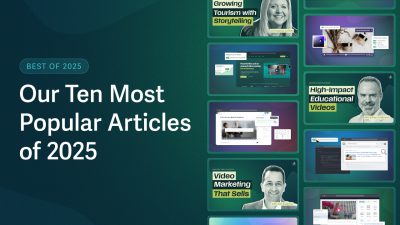Maybe you’ve been at it for a while, or maybe a newly remote workforce inspired the C-suite to take on more rigorous internal communications. Either way, creating a workable editorial calendar for executive communications is an important undertaking that will support your company’s culture and growth over time.
Whether you’re adding video to the mix, or building internal communications from scratch, video will greatly enhance your strategy. By adding personality and nuance, video is a highly effective tool for getting a message across. From branding to employee engagement, video is key to delivering results with internal comms.
So, what should that executive editorial calendar look like? While we don’t believe it’s one-size fits all, these eight best practices will get you started on the right foot.
1. Set Clear Goals
You can achieve many different aims with executive communications. Whether you’re looking to promote transparency, align teams with your mission, or share timely reactions to current events, it’s important to be specific when defining your goals.
Your company’s needs will be driven by company culture, the nature of the industry you’re in, and your teams’ specific needs for information. In all likelihood, your communications program will be fairly unique, even when compared to your peers.
2. Design Your Campaigns
Yes, we said campaigns, not just content. That’s because one-off videos shared periodically throughout the year are unlikely to move the needle. If you make a concerted effort to develop a series of videos to support different outcomes, you’re much more likely to get your message across to employees.
Also, the more video you make, in many ways, the easier it becomes. The first video is almost always the hardest to make.
To build your editorial calendar, you’ll want to draw from multiple sources. There are external factors, like current events, holidays, and industry-related events. Then, there are all the internal milestones, reporting periods, and strategic or cultural initiatives to take into account.
First, add all the foreseeable items with relatively fixed dates. Items like an annual report, conferences, or quarterly company-wide meetings are unlikely to shift on the schedule.
Then, layer in different initiatives, campaigns, and other more variable projects. By first getting a sense of your fixed deliverables, you’ll have a better picture of your workload, and can avoid going overboard with your messaging.
3. Plan and Budget Your Content
Once you’ve got a sense of your priorities for the year, it’s time to figure out the types of productions you’ll need, and what they’re likely to cost you. Most of your content will be split into two buckets: evergreen, and timely.
Evergreen Content
Evergreen content refers to video messaging that can be referenced again and again, and provides value for an extended period of time.
Examples include new hire welcome videos, training videos, and videos designed to uphold company culture.
Typically, evergreen videos are worth investing in because of their desired longevity. Higher production value will help prolong their shelf-life. Whether you can handle it in-house, or need to enlist a studio, these videos will require a fair amount of planning and time to get right.
Timely Content
Timely content is reactionary, and gives executives a chance to deliver a message to employees at a crucial moment.
While you might automatically equate timely content with reactions to events in the news, this category would also include videos or live streams that address things with short term value, like quarterly reports or most company updates.
For items that you can plan in advance, having a formula will make production more efficient. Figure out which shots you’ll need, and which assets (like charts or graphics), as well as who will be featured in the video.
For truly off-the-cuff videos, keeping production simple will ensure a speedy turnaround time. For instance, have the executive face a window for diffuse, flattering light, and get a microphone as close as possible for clear audio. That’s about it! If you have the equipment on hand, you can be set up to film in a matter of minutes.
4. Production Schedule
Each video should have a pre-production phase (planning), the production itself, post-production (editing), and finally, review and approval. The more accurately you can map out these phases, the more smoothly your shoots will run.
Based on the types of content you have planned, you should start to get a clear picture of your production needs. Evergreen content will likely require more time and effort for ideation, scripting, casting (yes, even employees and executives require casting), scouting, prop sourcing, filming, and of course editing. Timely content should require a lighter touch in terms of production. For instance, some may not be scripted, and the editing required will not be very involved.
For both types of video, there is likely to be a review and approval process. Depending on the nature of the content or your industry, this could be lengthy and could become an obstacle to delivering your message on time. Try to get buy-in from stakeholders early and often in the process, and ensure comms guidelines are clear to minimize this risk.
When scheduling productions, consider whether you can bunch certain shoots together. Also, look for opportunities to capture b-roll outside of formal productions. For instance, if an executive is speaking at an event, you might be able to use the footage as b-roll.
5. Release Cadence
The right release cadence for your content depends on the types of internal comms you are delivering. Some campaigns might require weekly or even daily updates, while others will occur far less often. For instance, in a time of crisis, your team might benefit from daily updates from executives. During the course of regular business, they’re unlikely to have the same information needs.
Most companies probably don’t do enough for internal comms. Data from Simpplr shows “two-thirds of leaders aren’t communicating about vision and strategy more frequently than once a quarter”. Surely there’s more to say about it than that?
The key is to strike a balance between establishing your comms program as a useful resource for employees, and bombarding them with lots of content. If your messaging is overwhelming, people will tune out. If it’s too sparse, it’s unlikely to provide a tangible benefit.
6. Secure Sharing
While some executive communications can be shared outside the company, certain videos will be for employees only. You can easily control access to your videos with SproutVideo’s privacy tools.
For instance, you can embed videos securely in an intranet using a domain whitelist. The embed code will not load if it’s copied to a website that isn’t included in your whitelist.
If you can’t easily embed content in your intranet, or don’t have one, a secure video portal for employees makes it easy to create a destination for your content. With password protection, viewer logins, or more advanced options, like IP address restriction or single sign-on, SproutVideo’s websites are an easy way to share your executive communications with the team.
7. Audience Interactions
Executive communications are not always a one-way street. It can be vitally important to gather employee feedback.
Enabling commenting on your videos and live streams is an engaging way to encourage employees to share their thoughts. It’s also a nice option because someone else can moderate the comments, while the person presenting focuses on their material.
Other alternatives include adding a survey at the end of the video or live stream with a custom post play screen, or linking to a survey during playback using an in-player call-to-action.
8. Track Performance
After going to all this effort, naturally, you’ll want to be sure you’re having a measurable impact. That’s where viewer engagement tracking comes in.
Depending on how you’re sharing your videos, you should be able to track viewers by their email address. This is possible whether you’re sharing your videos on an intranet, or through a SproutVideo website.
The viewer’s email address will be reported in engagement metrics. This powerful data shows you exactly how much of your video viewers watch, rewatch, or skip. That way, you will know whether your team is engaging with your content or if they’re dropping off at particular points in your videos.
Using this data, you can improve your videos over time, and ensure you’re only putting out effective content employees want to watch.
Do you use video for executive communications? If so, how has it made an impact? If not, what’s stopping you from getting started? Share your thoughts in the comments below.








